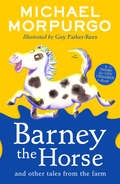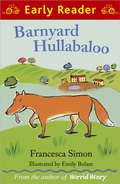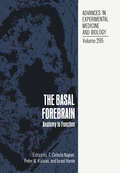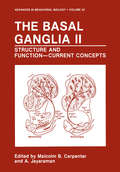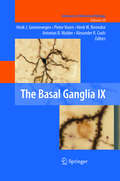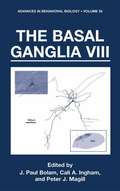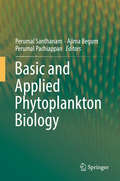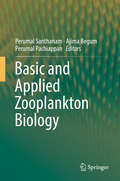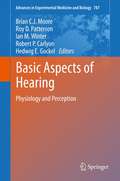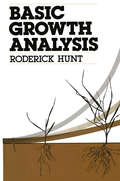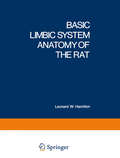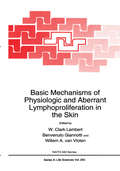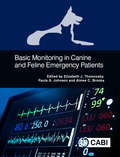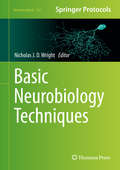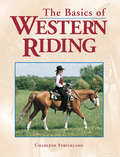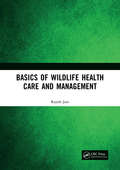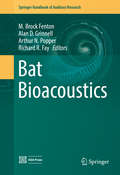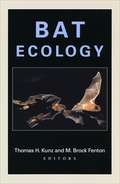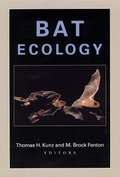- Table View
- List View
Barney the Horse and Other Tales from the Farm: A Farms For City Children Book (A Farms for City Children Book)
by Michael MorpurgoFull of friendship and adventure, this charming story collection from Michael Morpurgo and illustrated by Guy Parker-Rees is perfect to read together, and celebrates the way the countryside and its animals can leave an impression on a child’s heart forever.
Barnyard Hullabaloo (Early Reader)
by Francesca SimonEarly Readers are stepping stones from picture books to reading books. A blue Early Reader is perfect for sharing and reading together. A red Early Reader is the next step on your reading journey.Naughty Fox is on the prowl again, and the animals of Potter's Barn must come up with a plan to get rid of him once and for all. It's time to create a Barnyard Hullabaloo!
Barrie: How a rescue dog and her owner saved each other
by Sean LaidlawThe remarkable true story that became a viral news sensation.Former Royal Engineer Sean Laidlaw was working as a bomb disposal expert in Syria when he heard whimpering from the rubble of a school that had exploded and collapsed. Upon further inspection he found that the source of the noise was a tiny, abandoned puppy, surrounded by her four dead siblings. A terrified Barrie initially rejected Sean's advances - but he refused to give up. He made sure she was safe and brought her food and drink, and cordoned off the area to ensure it was safe from explosives. After a few days Barrie grew to trust Sean and eventually the two became inseparable in the three months he was in Syria.Sean had to return to the UK, leaving Barrie behind. When his contract wasn't renewed he knew he had to bring Barrie home. The two created an unbreakable bond and they were reunited in emotional scenes that have made headlines all over the world. Sean credits Barrie with helping him with his PTSD and their story is a powerful reminder of the incredible bond that dogs and humans have, and how both can save the other.
Barry Loser and the trouble with pets (Barry Loser Ser. #11)
by Jim SmithThe eleventh book in this Roald Dahl Funny Prize-winning series. Perfect for fans of Diary of a Wimpy Kid, Dog Man, Tom Gates and Pamela Butchart.
Barry Loser and the trouble with pets (Barry Loser Ser. #11)
by Jim SmithThe eleventh book in this Roald Dahl Funny Prize-winning series. Perfect for fans of Diary of a Wimpy Kid, Dog Man, Tom Gates and Pamela Butchart.
The Basal Forebrain: Anatomy to Function (Advances in Experimental Medicine and Biology #295)
by T. Celeste Napier Peter W. Kalivas Israel HaninThe basal forebrain has received considerable attention in recent years. This emphasis resulted from observations that the cortically projecting cholinergic neurons found in this region are critical for normal information processing. However, to achieve a complete understanding of such a complex function as "information processing" it is necessary to consider the basal forebrain not as an autonomous structure with a solitary task, but one that plays an integrative role; a structure that is connected intimately with many brain regions. This view evolved from the realization that the basal forebrain interfaces cognitive and reward functions with motor outputs. It is from this integrative and functional perspective that the present book was organized. The book is a unique collection of reports pertaining to the basal forebrain that encompasses a diversity of research approaches and techniques. It provides the reader with a progression of information that begins with anatomical descriptions of the afferent and efferent systems, stressing the integrative nature of various neurotransmitters located within the basal forebrain. The chapters focusing on anatomy are complemented by electrophysiologic studies that merge anatomical concepts with synaptic pharmacology and behavior. In vitro experiments demonstrate physiologic variations in anatomically identified neuronal subtypes and, together with in vivo techniques, provide pharmacologic descriptions of neuronal consequences to various neurotransmitter influences. Additional in vivo reports correlate changes in neuronal activity with specific motivational states and motor behaviors. These functional approaches culminate with behavioral studies that overview current understanding of basal forebrain involvement in mnemonic, reward, and motor processes.
The Basal Ganglia II: Structure and Function—Current Concepts (Advances in Behavioral Biology #32)
by Malcolm B. CarpenterThis volume was generated from papers presented at the Second Triennial Symposium of the International Basal Ganglia Society (IBAGS) held at the University of Victoria, British Columbia, July 21-23, 1986. The meeting was held as a satellite symposium following the XXX Congress of the International Union of Physiological Sciences at Vancouver. IBAGS was founded at a similar satellite symposium held in Lorne, Australia, organized by John S. McKenzie and sponsored by the University of Melbourne. The symposium held in Australia was attended by 50 scientists from 12 different countries. The results of the first symposium, edited by John S. McKenzie, Robert E. Kemm and Lynette N. Wilcock, were published by Plenum Press in 1984 under the title, The Basal Ganglia - Structure and Function. It was decided that the Society should meet on a triennial basis. The time and place for Second IBAGS Symposium were set by A.G. Phillips who served as Chairman of the Program Committee along with I. Divac, S.A. Greenfield and E.T. Rolls and J.S. McKenzie. Michael E. Corcoran of the Department of Psychology, University of Victoria served as the on-site coordinator and arranger for the Symposium. He was ably assisted by Ms. Morag McNeil who handled the details which made the meeting run smoothly.
The Basal Ganglia IX (Advances in Behavioral Biology #58)
by Hendrik Jan Groenewegen Pieter Voorn Henk W. Berendse Antonius B. Mulder Alexander R. CoolsThe aim of the International Basal Ganglia Society (IBAGS) is to further our understanding of normal basal ganglia function and the pathophysiology of disorders of the basal ganglia, including Parkinson's disease, Huntington's disease, and schizophrenia. Each triennial meeting of IBAGS brings together basic research scientists from all disciplines as well as clinicians who are actively involved in the treatment of basal ganglia disorders, to discuss the most recent advances in the field and to generate new approaches and ideas for the future. This volume comprises the proceedings of the 9th meeting of IBAGS, held in Egmond aan Zee, The Netherlands, September 2nd-6th, 2007.
The Basal Ganglia VIII (Advances in Behavioral Biology #56)
by Cali A. Ingham Peter J. Magill John Paul BolamThe aim of the International Meetings of the Basal Ganglia Society (IBAGS) is to provide a unique environment for the open presentation and discussion of new and challenging information about the basal ganglia as it relates to health and disease, covering all areas of basic science and research. Specific topics of the proceedings of this Eighth International Triennial Meeting of the Basal Ganglia Society include behavior, circuitry, functional imaging, modelling, movement disorders, neuropathology, neurotransmitters, pharmacology, physiology, plasticity, treatments for basal ganglia disorders, ventral systems, health and disease, immunology and basal ganglia, and much more.
Basic and Applied Phytoplankton Biology
by Perumal Santhanam Ajima Begum Perumal PachiappanThis book presents the latest developments and recent research trends in the field of plankton, highlighting the potential ecological and biotechnological applications. It critically and comprehensively discusses strain selection, growth characteristics, large-scale culturing, and biomass harvesting, focusing on the screening and production of high-value products from algae, and evaluating carbon dioxide sequestration from fuel gas as a climate change mitigation strategy. The latter areas of research are clearly central to the sustainable development approach that is currently attracting global attention.Over the decades, much of the literature on has focused on the biological and ecological aspects of phytoplankton found in freshwater, marine and brackish water environments. However, these organisms are known to also inhabit various other environments. More recently, there has been a substantial shift toward the concept of sustainable development and the “green economy” with emphasis on exploiting biological systems for the benefit of mankind. The significance of these plankton cannot be underestimated as they contribute approximately 40% of the oxygen in the atmosphere. Therefore, there is potential for exploitation of this invaluable biomass source that could lead to significant environmental and economic benefits for man.Providing a comprehensive outline of the most recent developments and advances in the field of industrial applications of these plankton, this book is an excellent reference resource for researchers and practitioners.
Basic and Applied Zooplankton Biology
by Perumal Santhanam Ajima Begum Perumal PachiappanThe coastal and ocean ecosystem is a significant feature of our planet and provides a source of food for much of life on Earth. Millions of species have been, and are still being discovered in the world’s oceans. Among these zooplankton serve as secondary producers and are significant as they form pelagic food links and act as indicators of water masses. They constitute the largest and most reliable source of protein for most of the ocean’s fishes. As such, their absence or depletion often affects fishery. In many countries, the decline in fishery has been attributed to reduced plankton populations. Furthermore, trillions of tiny copepods produce countless faecal pellets contributing greatly to the marine snow and therefore accelerating the flow of nutrients and minerals from the surface waters to the seabed. They are phylogenetically highly successful groups in terms of phylogenetic age, number of living species and success of adaptive radiation. A study of the basic and applied aspects of zooplankton would provide an index of the fishery potential and applications, offering insights into ocean ecology to safeguard food supplies and livelihoods of the millions of people living in coastal areas. For this reason, we need to understand all the facets of zooplankton as well as their interactions with atmosphere and other life forms, including human. In this context, this book discusses the basic and applied aspects of zooplankton, especially taxonomy, mosquitocidal activity, culture, analysis of nutritional, pigments and enzyme profile, preservation of copepods eggs, bioenrichment of zooplankton and application of zooplankton in sustainable aquaculture production, focusing on novel biofloc-copefloc technologies, and the impact of acidification and microplastics on zooplankton.Offering a comprehensive overview of the current issues and developments in the field of environmental and commercial applications, this book is a valuable resource for researchers, aquaculturists, environmental mangers wanting to understand the importance of zooplankton and develop technologies for the sustainable production of fish and other commodities to provide food and livelihoods for mankind.
Basic and Clinical Perspectives in Vision Research: A Celebration of the Career of Hisako Ikeda
by AnthonyTaylor Mustafa B. A.Djamgoz Jon G. RobbinsI have been asked to write a brief foreword to this volume honoring Hisako Ikeda, providing a review of the accomplishments in our field over the past four decades, when Hisako was an active participant. This I am delighted to do. It has been a most exciting time in vision research and Hisako has been right in the middle of much of the excitement, publishing on a wide variety of topics and providing much new data and many new insights. Hisako's research career can be divided by decades into four quite distinct areas of inquiry. In the 1950s, as a student in Japan, her research interests were psychophysical in nature, and she was concerned with visual illusions, figural aftereffects, and motion detec tion. In the 1960s, after her move to London, she began electrophysiological studies. Much of her work in the 1960s was concerned with the electroretinogram (ERG), its components, and the use of this electrical response for evaluating spectral sensitivities of the eye and retinal degenerations. This work represented the beginning of her electrodiagnostic clinical work, which continued until her retirement.
Basic Aspects of Hearing: Physiology and Perception
by Brian C. J. Moore, Roy D. Patterson, Ian M. Winter, Robert P. Carlyon and Hedwig E GockelThe International Symposium on Hearing is a highly-prestigious, triennial event where world-class scientists present and discuss the most recent advances in the field of hearing research in animals and humans. Presented papers range from basic to applied research, and are of interest neuroscientists, otolaryngologists, psychologists, and artificial intelligence researchers. Basic Aspects of Hearing: Physiology and Perception includes the best papers from the 2012 International Symposium on Hearing. Over 50 chapters focus on the relationship between auditory physiology, psychoacoustics, and computational modeling.
Basic Growth Analysis: Plant growth analysis for beginners
by R. HuntThis handbook is intended as an introductory guide to students at all levels on the principles and practice of plant growth analysis. Many have found this quantitative approach to be useful in the description and interpretation of the performance of whole plant systems grown under natural, semi-natural or controlled conditions. Most of the methods described require only simple experimental data and facilities. For the classical approach, GCSE biology and mathematics (or their equivalents) are the only theoretical backgrounds required. For the functional approach, a little calculus and statistical theory is needed. All of the topics regarding the quantitative basis of productivity recently introduced to the Biology A-level syllabus by the Joint Matriculation Board are covered. The booklet replaces my elementary Plant Growth Analysis (1978, London: Edward Arnold) which is now out of print. The presentation is very basic indeed; the opening pages give only essential outlines of the main issues. They are followed by brief, standardized accounts of each growth-analytical concept taken in turn. The illustrations deal more with the properties of well-grown material than with the effects of specific environmental changes, even though that is where much of the subject's interest lies. However, detailed references to the relevant parts of more com prehensive works appear throughout, and a later section on 'Inter relations' adds perspective. Some 'Questions and answers' may also help to show what topics will arise if the subject is pursued further.
Basic Limbic System Anatomy of the Rat
by Leonard HamiltonIf this were a traditional textbook of neuroanatomy, many pages would be devoted to a description of the ascending and descending pathways of the spinal cord and several chapters to the organization of the sensory and motor systems, and, perhaps, a detailed discussion of the neurological deficits that follow various types of damage to the nervous system would also be included. But in the first draft of this book, the spinal cord was mentioned only once (in a figure caption of Chapter 2) in order to illustrate the meaning of longitudinal and cross sections. Later, it was decided that even this cursory treatment of the spinal cord went beyond the scope of this text, and a carrot was substituted as the model. The organization of the sensory and motor systems and of the peripheral nervous system have received similar coverage. Thus, this is not a traditional text, and as a potential reader, you may be led to ask, "What's in this book for me?" This book is directed primarily toward those students of behavior who are either bored or frightened by the medically oriented texts that are replete with clinical signs, confusing terminology, and prolix descriptions of the human brain, an organ which is never actually seen in their laboratories. I should hasten to add, however, that this text may also serve some purpose for those who read and perhaps even enjoy the traditional texts.
Basic Mechanisms of Physiologic and Aberrant Lymphoproliferation in the Skin (Nato Science Series A: #265)
by W. Clark Lambert Benvenuto Giannotti Willem A. Van VlotenThis book is based upon a series of papers originally presented at a NATO Advanced Studies Workshop of the same title held at the study Center HI Cappuccini," a converted monastery in San Miniato, a small village located between Pisa and Florence, Italy, in October 1991. Authors were asked to submit their completed chapters by the following February; these were then scanned onto computer disks, edited and returned to the authors for final revision, and updating, with a final deadline of February 1993. The authors were encouraged to make whatever modifications they wanted, especially regarding updating their chapters, with an eye to making the final product both comprehensive and current. In this we succeeded beyond our expectations, with most chapters extensively altered and many completely re-written and significantly expanded. Thus, although the original meeting was held in 1991, the chapters in this volume may be regarded as current from at least February, 1993, with some of the final updated revisions received as late as July, 1993. This book, as agreed in our original contract, has been delivered to the publisher "camera-ready. " This means that all of the scanning, editing, proofing and typesetting were done here, by the office of the Department of Dermatology at the New Jersey Medical School. We essentially produced the book, which the publisher, for the most part, then photocopied. This has been an enormous burden, borne mainly by my colleague in this division, Robert A.
Basic Monitoring in Canine and Feline Emergency Patients
by Daniel S Foy Danielle Hundley Laura Ilie Kristen Marshall Adesola Odunayo Jessica L WardThis book discusses basic monitoring techniques that can be easily performed on emergency canine and feline patients in both first line emergency and primary care clinics. Techniques include blood pressure measurement, capnography, electrocardiography, pulse oximetry, and point of care monitoring ranging from the physical exam to bedside ultrasound and diagnostic tests such as PCV/TP, blood glucose and lactate. Each chapter begins with basic physiology as related to the monitoring technique, before reviewing how the piece of equipment used for monitoring works, pros and cons of the equipment, and limitations of the device. A simple, consistent layout for each chapter makes it easy to quickly locate information within the book. A final section in each chapter gives practical examples of how to use the monitoring technique in a clinical setting. The book also: - Emphasizes how physiology ties into what information each technique does (and does not) provide; - Includes pictures, tables, and diagrams to help explain concepts; - Delivers guidelines for rational interpretation of the results acquired. An important resource for both veterinary practitioners and students, this book provides a succinct approach to understanding the monitoring equipment used in emergency patients.
Basic Neurobiology Techniques (Neuromethods #152)
by Nicholas J. D. WrightThis volume explores the latest techniques and improved methods used to study important neurobiological and associated neuropathological conditions. Chapters cover topics such as the application of semiconductor quantum dots as photostable fluorophores used for labeling and tracking; GCaMP6 transcranial imaging to monitor neural activity; the patch-clamping technique allowing simultaneous monitoring of membrane currents and optical signals; and quantifying behavioral dysfunction caused by traumatic brain injury (TBI). In Neuromethods series style, chapters include the kind of detail and key advice from the specialists needed to get successful results in your laboratory.Cutting-edge and practical, Basic Neurobiology Techniques is a valuable resource for novel and expert researchers interested in expanding their knowledge of this developing field.
The Basics of Western Riding
by Charlene StricklandGet in the saddle and experience the thrills, challenges, and fun of Western riding! In this comprehensive introductory guide, veteran trainer Charlene Strickland covers everything from safe horse handling procedures and basic Western riding techniques to stylish competition outfits. With plenty of encouragement and a contagious passion, Strickland provides easy-to-follow riding instructions along with expert advice on evaluating horses and appropriate tack. You&’ll soon be enjoying pleasurable rides both in the training ring and out on the trail.
Basics of Wildlife Health Care and Management
by Rajesh JaniThe book provides basic understanding of the various topics of wildlife which will be useful for biologist, zoologist, veterinarians working in forest ,zoos or at field level where they use to get wild animals for post mortem or for treatment. It also provides helpful information to the forest officers, zoo managers and protected area managers for critical care management and for doing needful things before approaching a veterinarian to save the life of animal or to collect biological material useful for diagnosis. Note: T&F does not sell or distribute the Hardback in India, Pakistan, Nepal, Bhutan, Bangladesh and Sri Lanka.
Basics of Wildlife Health Care and Management
by Rajesh JaniThe book provides basic understanding of the various topics of wildlife which will be useful for biologist, zoologist, veterinarians working in forest ,zoos or at field level where they use to get wild animals for post mortem or for treatment. It also provides helpful information to the forest officers, zoo managers and protected area managers for critical care management and for doing needful things before approaching a veterinarian to save the life of animal or to collect biological material useful for diagnosis. Note: T&F does not sell or distribute the Hardback in India, Pakistan, Nepal, Bhutan, Bangladesh and Sri Lanka.
Bat Bioacoustics (Springer Handbook of Auditory Research #54)
by M. Brock Fenton Alan D Grinnell Arthur N. Popper Richard R. FayArguably biosonar is one of the ‘eye-opening’ discoveries about animal behavior and the auditory systems of echolocators are front and center in this story. Echolocation by bats has proven to be a virtual gold mine for colleagues studying neurobiology, while providing many rich examples of its impact on other areas of bats’ lives. In this volume we briefly review the history of the topic (reminding readers of the 1995 Hearing by Bats). We use a chapter on new findings in the phylogeny of bats to put the information that follows in an evolutionary context. This includes an examination of the possible roles of Prestin and FoxP2 genes and various anatomical features affecting bat vocalizations. We introduce recent work on the role of noseleafs, ears, and other facial components on the focusing of sound and collection of echoes.
Bat Ecology
by Thomas H. Kunz M. Brock FentonIn recent years researchers have discovered that bats play key roles in many ecosystems as insect predators, seed dispersers, and pollinators. Bats also display astonishing ecological and evolutionary diversity and serve as important models for studies of a wide variety of topics, including food webs, biogeography, and emerging diseases. In Bat Ecology, world-renowned bat scholars present an up-to-date, comprehensive, and authoritative review of this ongoing research. The first part of the book covers the life history and behavioral ecology of bats, from migration to sperm competition and natural selection. The next section focuses on functional ecology, including ecomorphology, feeding, and physiology. In the third section, contributors explore macroecological issues such as the evolution of ecological diversity, range size, and infectious diseases (including rabies) in bats. A final chapter discusses conservation challenges facing these fascinating flying mammals. Bat Ecology is the most comprehensive state-of-the-field collection for scientists and researchers. Contributors: John D. Altringham, Robert M. R. Barclay, Tenley M. Conway, Elizabeth R. Dumont, Peggy Eby, Abigail C. Entwistle, Theodore H. Fleming, Patricia W. Freeman, Lawrence D. Harder, Gareth Jones, Linda F. Lumsden, Gary F. McCracken, Sharon L. Messenger, Bruce D. Patterson, Paul A. Racey, Jens Rydell, Charles E. Rupprecht, Nancy B. Simmons, Jean S. Smith, John R. Speakman, Richard D. Stevens, Elizabeth F. Stockwell, Sharon M. Swartz, Donald W. Thomas, Otto von Helversen, Gerald S. Wilkinson, Michael R. Willig, York Winter
Bat Ecology (PDF)
by Thomas H. Kunz M. Brock FentonBats display astonishing ecological and evolutionary diversity and serve as important models for studies of a wide variety of topics, including food webs, biogeography, and emerging diseases. In "Bat Ecology", world-renowned bat scholars present an up-to-date, comprehensive, and authoritative review of this ongoing research. The first part of the book covers the life history and behavioral ecology of bats, from migration to sperm competition and natural selection. The next section focuses on functional ecology, including ecomorphology, feeding, and physiology. In the third section, contributors explore macroecological issues such as the evolution of ecological diversity, range size, and infectious diseases (including rabies) in bats. A final chapter discusses conservation challenges facing these fascinating flying mammals.
Batpants!
by Jeremy StrongBATPANTS the orang-utan is completely, wildly HAIRY. She loves swinging through trees, and apple crumble and roast chicken. But most of all she loves her family, the Loveharts, and all their madcap adventures.Mrs Lovehart is a stuntwoman and so the whole family is off to watch her in action in her latest film. But someone on set has an eeeevil plan and things could turn nasty - will it be Batpants to the rescue?
